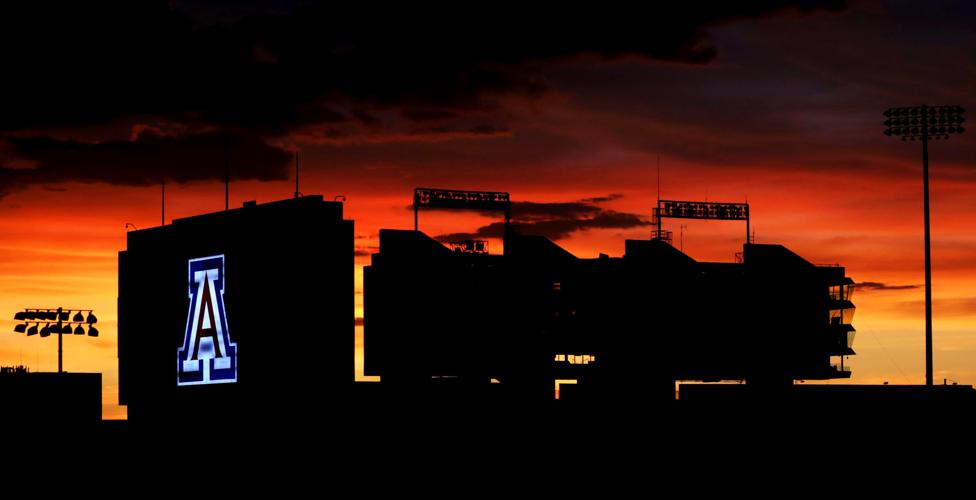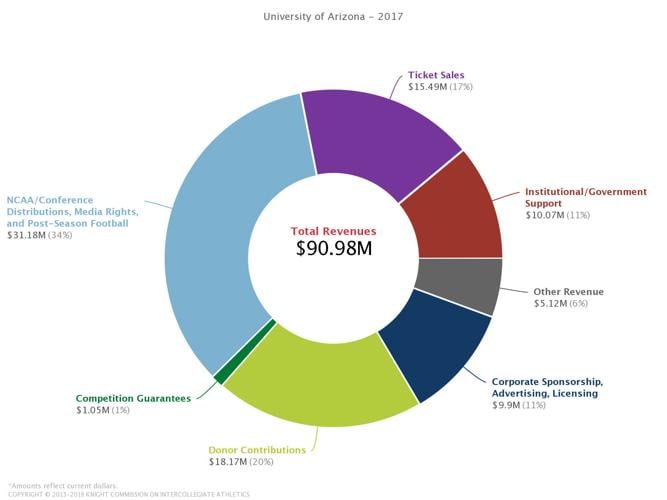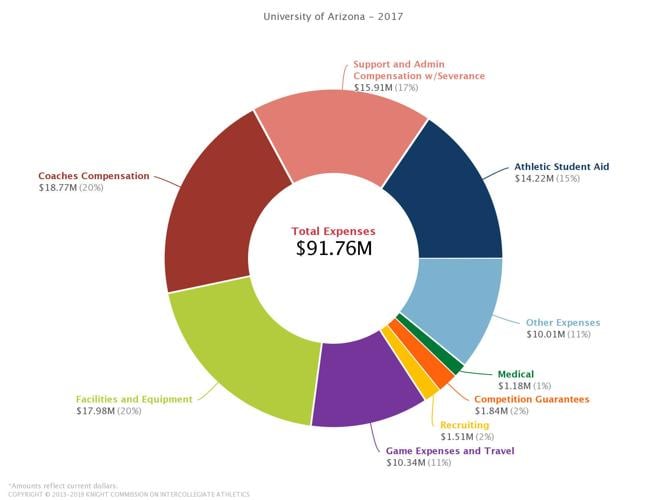The Arizona Wildcats will open the 2019 season on Saturday night at Hawaii, and the financial stakes have never been higher. Spending on football has nearly tripled since 2004, with Wildcats coaches’ salaries surpassing both the Pac-12 and Power 5 conference averages.
Data obtained by the Star via the Knight Commission on Intercollegiate Athletics’ College Athletic Financial Information database paints a picture where both spending and revenue have increased, fueled in part by a lucrative media rights package with the Pac-12 Networks and money received from bowl games. The UA is using some of its revenue to enhance wellness options for Wildcats athletes and improving fan experiences at games.
The Knight Commission posted data from 2004 through 2017, the most recent year available, to advance transparency and understanding of the way athletic departments work. The data, collected from Division I schools’ self-reported NCAA Financial Report Forms, shows:
- In the 2004-05 academic year, total football spending at the UA was roughly $8.5 million, with $2.6 million spent on coaches’ salaries. Twelve years later, during the 2016-17 academic year, football spending had increased to $21.7 million, with $8.5 million dedicated to coaches’ salaries. Coaches’ pay exceeded both the Pac-12 median ($7.6 million) and FBS median ($4.7 million).
- Athletic department expenses more than doubled between 2004 and 2017, increasing from $40.7 million to $91.8 million. The Pac-12 median for athletic spending in 2017 was reported as just over $95 million.
- During the 2016-17 academic year, more than half of the UA athletic department’s expenses went toward salaries, facilities and equipment. Coaches, support and administrative salaries accounted for $34.7 million — roughly 37% of spending. Facilities and equipment, at $17.98 million, made up 20% of athletic department expenses. Student aid for athletes made up 15% of spending, with $14.22 million in scholarships paid out. Game expenses and travel made up 11%, at just over $10 million. These figures don’t include the multimillion buyout the UA paid former football coach Rich Rodriguez in early 2018, the hiring of his replacement, Kevin Sumlin, or recent contract extensions given out to coaches in other sports.
- The largest chunk of the UA’s athletic department revenue now comes from NCAA and conference distributions, media rights and bowl game payouts. Those figures accounted for $31.18 million in the 2016-17 school year, making up 34% of department revenue. Ticket sales accounted for 17% of revenue, with fans spending $15.5 million to attend sporting events. Donors contributed an additional $18.17 million.
“This CAFI database helps flesh out the good and the bad in major college sports finances so we can have an informed debate about priorities,” said Knight Commission co-chair Arne Duncan, former U.S. Secretary of Education. “At a time when all of U.S. higher education is appropriately under pressure to be more transparent to the public and more accountable for producing better outcomes, intercollegiate athletics must be held to the same standards and scrutiny.”
The Knight Commission believes that transparency of athletic department finances is critical to the long-term health of college sports, said CEO Amy Perko.
“The CAFI database clearly describes where the money comes from and where the money goes in college sports,” Perko said. “The trends impacting Division I institutions vary greatly depending on whether they are members of one of the Power 5 conferences.”
The UA’s revenue and spending habits fall in line with Pac-12 trends over the last few years, which shows that the UA’s athletic department is both effective and efficient with its resources, said Derek van der Merwe, the UA’s assistant vice president of athletics and the athletic department’s CEO.
“If you correlate that to the success that we’ve had across all our sports programs, when you’re operating at the league median and achieving the results we have year after year, that shows a lot of effectiveness and efficiency when it comes to the utilization of resources,” said van der Merwe, who came to the UA last June from Austin Peay.
The UA’s history of great people and dedicated fans has so far defined its success, according to van der Merwe.
“During the course of my career I’ve had a chance to work at mid-major institutions to a low resource institution to an FBS Power 5-type program, and what’s interesting about as you move between the different levels is that everybody is faced with the same set of challenges,” van der Merwe said. “We’re not different or unique; just how we approach the challenges and how we prioritize certain issues in supporting the success of our student athletes is unique to us. We may prioritize things more than other people do.”
Supporting student-athletes and ensuring they achieve success at the UA is the school’s moral imperative, van der Merwe said. The UA completed a strategic plan last fall and in response, the athletic department launched its own strategic planning process to identify financial priorities going forward. The plan, which will be released in the coming months, will prioritize initiatives involving student-athlete wellness, including mental health support, medical support and academic support.
The sports industry is highly technical, with constantly changing ideas about nutrition, mental health, medical support and rehabilitation. The teams at the UA that work in those areas are national leaders and very well respected in their field, van der Merwe said.
“How do we continue to enhance and improve the experience of our student-athletes while there here and keep them safe? Those are things that are dimensionally our priorities going forward,” van der Merwe said.
Athletic department officials are also continuing to enhance what they call “the fan experience.” It’s been a priority for athletic director Dave Heeke since he was hired in February 2017. Last year, the UA introduced wine and beer sales to the general public at Wildcats’ basketball and football games. Hillenbrand Stadium, the Wildcats’ longtime softball home, was demolished and rebuilt. Nowhere is the fan experience more important than at Arizona Stadium. At Heeke’s direction, the UA redesigned the Zona Zoo student section last year. Suite renovations are underway, with plans to eventually modernize the stadium’s west side.
Renovated facilities help in recruiting and coach retention, and could motivate fans who have stopped attending games to return.
“There’s a shifting consumer demand that’s happening in sports across the country. Consumers come to games more than just to watch the game itself; it’s about the experience,” van der Merwe said. “Everyone wants to experience the game in a different way, so making sure we’re attentive to the full multigenerational family experience, because your consumers are shifting.”
The athletic department launched a business intelligence unit last fall that has been analyzing the needs and demands of UA fans, van der Merwe said. The unit meets every other week and looks at social media, website, and ticket-holder analytics to analyze both the demographics of their fans and the behavior that’s driving their engagement with the UA.
Middle-aged and older men are the primary demographic for football and men’s basketball games, van der Merwe said. But those figures are starting to change: Season ticket holders don’t always use their tickets, and more families and women are attending games.
“That population, as they continue to grow, their experience shifts. They’re coming for a multigenerational experience with their kids. They come because of the tailgating and being a part of that experience and it evolves as they grow and change ,” van der Merwe said. “We’re trying to understand each of those sequences to make sure we’re growing with them.”
The UA is locked into a fixed agreement with the Pac-12 Networks for the next several years, meaning that media rights streams will remain about the same. Van der Merwe said that ticket sales and donor support will always be a significant part of Arizona’s plan to compete.
The UA is looking at all possible revenue streams — including facility rentals, sales and transactions, and contracts with other businesses.
Heeke has been proactive when it comes to keeping successful coaches on campus.
In May, the UA extended women’s volleyball coach Dave Rubio’s contract through 2023. Rubio, who is in his 27th year with the Wildcats, has made 20 NCAA Tournament appearances, eight Sweet 16s, four Elite Eights and a Final Four. A month later, the Arizona Board of Regents approved a 70% raise for Arizona women’s basketball coach Adia Barnes, extending her contract through the 2023-24 season. Those extensions come on the heels of reworked deals for baseball coach Jay Johnson and softball coach Mike Candrea. Women’s golf coach Laura Ianello received a five-year extension last June, after her team won a national championship, and soccer coach Tony Amato received a three-year extension in March.
“I think that we are a training ground for elite-level athletes worldwide, if you look at the people that come out of here, I think it reflects that,” van der Merwe said.






